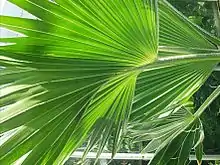Pritchardia affinis
Pritchardia affinis, the Hawai'i pritchardia,[3] is a species of palm tree that is endemic to the Hawaiian Islands. Wild populations currently exist on the leeward side of the Island of Hawaiʻi. It was most likely cultivated by Native Hawaiians, so its exact native range is uncertain. P. affinis reaches a height of 10–25 m (33–82 ft).[4] It is threatened by rats and pigs, which damage the trees and eat the seeds before they can grow. It is a federally listed endangered species of the United States. Its fruit was reportedly the preferred food of the now-extinct ula-ai-hawane—a niche that has been seemingly filled by the introduced lavender waxbill.

Sample shown in the US Botanic Garden.
| Pritchardia affinis | |
|---|---|
 | |
| Scientific classification | |
| Kingdom: | Plantae |
| Clade: | Tracheophytes |
| Clade: | Angiosperms |
| Clade: | Monocots |
| Clade: | Commelinids |
| Order: | Arecales |
| Family: | Arecaceae |
| Tribe: | Trachycarpeae |
| Genus: | Pritchardia |
| Species: | P. affinis |
| Binomial name | |
| Pritchardia affinis | |
References
- Gemmill, C. (1998). "Pritchardia affinis". IUCN Red List of Threatened Species. 1998: e.T38641A10141295. doi:10.2305/IUCN.UK.1998.RLTS.T38641A10141295.en. Retrieved 17 November 2021.
- "Pritchardia affinis". Germplasm Resources Information Network. Agricultural Research Service, United States Department of Agriculture. Retrieved 2 March 2011.
- USDA, NRCS (n.d.). "Pritchardia affinis". The PLANTS Database (plants.usda.gov). Greensboro, North Carolina: National Plant Data Team. Retrieved 14 October 2015.
- "Pritchardia affinis". CPC National Collection Plant Profiles. Center for Plant Conservation. Archived from the original on 2010-12-15. Retrieved 2011-03-02.
External links
 Media related to Pritchardia affinis at Wikimedia Commons
Media related to Pritchardia affinis at Wikimedia Commons Data related to Pritchardia affinis at Wikispecies
Data related to Pritchardia affinis at Wikispecies
This article is issued from Wikipedia. The text is licensed under Creative Commons - Attribution - Sharealike. Additional terms may apply for the media files.
